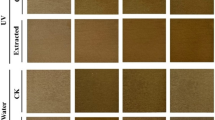Abstract
Heartwood extracts of Acacia confusa (HEAc) were proven to have the capability of ameliorating wood photostability. However, the efficacy of photostability compared with that of commercial photostabilizers was unknown. The aim of this study was to examine whether HEAc can be used as commercial photostabilizers. Comparison was made among commercially available photostabilizers, UV absorber (Eversorb 80, EV80) and hindered amine light stabilizer (Eversorb 93, EV93). Photostability of wood slices soaked in 1, 5 and 10 % HEAc or 1 % commercial photostabilizers (EV80 or EV93) solutions was evaluated. The discoloration of 5 and 10 % HEAc-treated specimens was significantly reduced after UV irradiation. Furthermore, lignin degradation and carbonyl formation were concurrently inhibited by 5 and 10 % HEAc treatments after UV irradiation. Interestingly, 1 % HEAc treatment showed similar effectiveness compared with EV80 treatment, while 5 and 10 % HEAc treatments showed better effectiveness than EV80 treatment. HEAc can absorb UV light and quench radicals; hence, wood photodegradation was consequently prevented. These results revealed that HEAc has great potential to be developed as a natural photostabilizer.








Similar content being viewed by others
Change history
01 September 2017
An erratum to this article has been published.
References
Andrady AL, Hamid H, Torikai A (2011) Effects of solar UV and climate change on materials. Photochem Photobiol Sci 10:292–300
Chang HT (2000) Effect of chemical modification on the durability of wood. Dissertation, National Taiwan University (In Chinese)
Chang TC (2010) Effect of extracts on wood photodegradation. Dissertation, National Taiwan University (In Chinese)
Chang HT, Chang ST (2006) Modification of wood with isopropyl glycidyl ether and its effects on decay resistance and light stability. Bioresour Technol 97:1265–1271
Chang TC, Chang HT, Wu CL, Chang ST (2009) Stabilizing effects of extractives on the photooxidation of Cryptomeria japonica heartwood. Q J Chin For 42:227–238 (In Chinese)
Chang TC, Chang HT, Wu CL, Chang ST (2010a) Influences of extractives on the photodegradation of wood. Polym Degrad Stab 95:516–521
Chang TC, Chang HT, Wu CL, Lin HY, Chang ST (2010b) Stabilizing effect of extractives on the photo-oxidation of Acacia confusa wood. Polym Degrad Stab 95:1518–1522
Chang TC, Lin HY, Wang SY, Chang ST (2014) Study on inhibition mechanisms of light-induced wood radicals by Acacia confusa heartwood extracts. Polym Degrad Stab 105:42–47
Chou PL, Chang HT, Yeh TF, Chang ST (2008) Characterizing the conservation effect of clear coatings on photodegradation of wood. Bioresour Technol 99:1073–1079
Falkovskaia E, Sengupta PK, Kasha M (1998) Photophysical induction of dual fluorescence of quercetin and related hydroxyflavones upon intermolecular H-bonding to solvent matrix. Chem Phys Lett 297:109–114
Forsthuber B, Schaller C, Grüll G (2013) Evaluation of the photo stabilising efficiency of clear coatings comprising organic UV absorbers and mineral UV screeners on wood surfaces. Wood Sci Technol 47:281–297
Hayoz P, Peter W, Rogez D (2003) A new innovative stabilization method for the protection of natural wood. Prog Org Coat 48:298–309
Heitner C (1993) Light-induced yellowing of wood-containing papers. In: Heitner C, Scaiano JC (eds) Photochemistry of lignocellulosic materials. American Chemistry Society, Washington, pp 2–22
Hon DNS, Feist WC (1992) Hydroperoxidation in photo-irradiated wood surfaces. Wood Fiber Sci 24:448–455
Huvaere K, Skibsted LH (2015) Flavonoids protecting food and beverages against light. J Sci Food Agric 95:20–35
Müller U, Ratzsch M, Schwanninger M, Steiner M, Zobl H (2003) Yellowing and IR-changes of spruce wood as result of UV-irradiation. J Photochem Photobiol B 69:97–105
Pandey KK (2005) Study of the effect of photo-irradiation on the surface chemistry of wood. Polym Degrad Stab 90:9–20
Pandey KK, Pitman AJ (2003) FTIR studies of the changes in wood chemistry following decay by brown-rot and white-rot fungi. Int Biodeterior Biodegrad 52:151–160
Parejo PG, Zayat M, Levy D (2006) Highly efficient UV-absorbing thin-film coatings for protection of organic materials against photodegradation. J Mater Chem 22:2113–2208
Pietta PG (2000) Flavonoids as antioxidant. J Nat Prod 63:1035–1042
Pospíšil J, Nešpurek S (2000) Photostabilization of coatings. Mechanisms and performance. Prog Polym Sci 25:1261–1335
Rabek JF (1990) Introduction to the oxidative and photo-stabilization of polymers. In: Rabek JF (ed) Photostabilization of polymers: principles and applications. Elsevier Applied Science, New York, pp 42–79
Sisa M, Bonne SL, Ferreira D, van der Westhuizen JH (2010) Photochemistry of flavonoids. Molecules 15:5196–5245
Tolvaj L, Mitsui K (2005) Light source dependence of the photodegradation of wood. J Wood Sci 51:468–473
Tung YT, Chang WC, Chen PS, Chang TC, Chang ST (2011) Ultrasound-assisted extraction of phenolic antioxidants from Acacia confusa flowers and buds. J Sep Sci 34:844–851
Wu JH, Tung YT, Wang SY, Shyur LF, Kuo YH, Chang ST (2005) Phenolic antioxidants from the heartwood of Acacia confusa. J Agric Food Chem 53:5917–5921
Acknowledgments
The authors acknowledge the financial support (NSC 102-2313-B-002-023-MY3) from the Ministry of Science and Technology Taiwan. We are also wishing to thank assistant research fellow Min-Jay Chung (the Experimental Forest, National Taiwan University) and Everlight Chemical Industrial Co. for the supports of materials and associate professor rank specialist Chun-Chieh Huang (Department of Wood Science and Design, National **tung University of Science and Technology) for the assistance of wood processing.
Author information
Authors and Affiliations
Corresponding author
Additional information
An erratum to this article is available at https://doi.org/10.1007/s00226-017-0950-5.
Rights and permissions
About this article
Cite this article
Chang, TC., Hsiao, NC., Yu, PC. et al. Exploitation of Acacia confusa heartwood extract as natural photostabilizers. Wood Sci Technol 49, 811–823 (2015). https://doi.org/10.1007/s00226-015-0722-z
Received:
Published:
Issue Date:
DOI: https://doi.org/10.1007/s00226-015-0722-z




